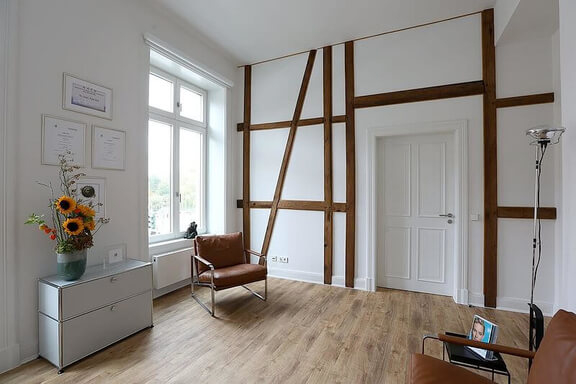Form and function - your nose only has to suit one person: you
The nose is a vitally important sensory organ. Unfortunately, it does not always match our ideals in terms of size and shape. An attractive nose blends harmoniously in with the rest of the face. Noses that are conspicuous or inappropriately proportioned, on the other hand, disrupt the harmony of the entire face.
And the shape of our noses determines not only our appearance, but our health and well-being as well. After all, noses are about breathing— but breathing that can be seriously impaired in some cases. This is why, when performing corrective rhinoplasty, we always account for both the form and the function of your nose.
“Nose jobs” are among the most common types of plastic surgery. Unfortunately, however, they are often performed using simple, conventional surgical techniques. Modern nasal surgery is completely different: Rather than merely removing tissue, the surgeon should approach each nose individually and reshape it in a targeted way (in what is known as “structure-preserving rhinoplasty”).
And this is the type of nasal surgery we are committed to providing, because nasal corrections are our specialty. Dr. Arlt’s specialist certifications in both plastic surgery and otolaryngology lay a perfect foundation for this specialization, not to mention his exclusive specialization in the face and his more than 25 years of experience in nasal operations.
SPECIAL CONSIDERATIONS IN CORRECTIVE RHINOPLASTY – STANDARD TECHNIQUES ARE NOT ENOUGH
The right corrective nasal surgery can harmonize the face wonderfully. But this type of operation places exceptional demands on the surgeon, since it is one of the most challenging plastic surgeries of all in terms of surgical technique.
Thus, the results of corrective nasal surgery are unfortunately not always satisfying, and follow-up operations (revisions) are not uncommon.
When performing nasal corrections, it is important to keep not only aesthetic aspects but also functional requirements in mind. And the surgeon must not only be familiar with the nose, but also have a good understanding of facial anatomy and facial proportions as a whole.
As such, the procedure is difficult to learn, and not every surgeon who performs nasal operations has the necessary training and experience.
Unfortunately, many surgeons rely merely on standard surgical techniques, which involve simply removing tissue from the nose (known as “resection rhinoplasty”). Such operations are quick and generally easy for non-specialized physicians to perform, but rather than yielding the desired results, they very often leave the face looking unnatural and/or “operated on”. This is why, here at our practice in Hamburg, we create individual surgical plans that are tailored precisely to each of our patients.
MODERN STRUCTURE-PRESERVING SURGICAL TECHNIQUE - RESHAPING INSTEAD OF RESECTION
Successful nose specialists always create detailed strategic surgical concepts that are adapted to the individual patient’s situation. Practically every nasal operation involves specific details that only become evident upon closer analysis, or sometimes only during the operation. In other words, corrective nasal operations are anything but standard operations!
Regardless of whether the desired change appears large or small at first glance, first impressions can be deceiving. It’s not enough to just remove a bump or take a little cartilage off the end of the patient’s nose (the standard method, known as resection rhinoplasty).
There are also surgical requirements regarding the stability of the nose, and these are just as important to the overall results, if not more so. Simply removing bone or cartilage from the nose necessarily weakens nasal structure; if surgeons do not account for this, the nose may change in an uncontrolled way after the operation, thereby ruining the results.
For this reason, modern nasal operations do not simply remove tissue, but rather reshape the nose in a targeted, individual way using detailed surgical techniques (so-called “structure-preserving” nasal surgery techniques).
Such methods require significantly greater amounts of time and effort, but the benefit is obvious: The support structure of the nose can be maintained or even strengthened if necessary, which is fundamental to ensuring good results, proper nasal function and long-term stability of the nose.
WHAT WE DO DIFFERENTLY
You will notice the difference immediately during the consultation as well as treatment planning. We divide our consultations into two parts:
- Initial consultation: Detailed examination of patient’s anatomy and individual requirements. Consultation: what is possible? Where are the limits?
- Pre-Op Planing: Detailed surgery plan (treatment plan); consultation: Approach, procedure, post-surgical treatment
Taking care of the things that are important to your nose requires more than a quick chat. A surgeon that considers your nose (and, therefore, you) in a differentiated way:
- needs to listen to your questions and requests
- needs to look closely, examine and analyze inside and out
- needs to weigh the alternatives and then select the methods that are most suited to your nose (and, therefore, to you)
- needs to clarify what seems feasible in your situation, and what does not. These limits are particularly important, because not everything is possible, and not every possibility is a sensible one
- needs to take difficulties and risks into account
You need all of these things so that you can make an informed decision (initial consultation = analysis). And all these things also require a mindful surgeon who can set up a treatment plan that suits your needs (second consultation = surgery planning).
This is why personal consultations are so important to us. We take the time we need for you, because thorough discussions are the only way to achieve what we consider the most important goal before any treatment: informed consensus between doctor and patient! Establishing this relationship of trust allows us to go about the treatment process together, as partners.
Corrective nasal surgery by means of modern structure-preserving rhinoplasty, rather than standard resection rhinoplasty, is the type of modern nasal surgery that we have committed ourselves to performing here at our Hamburg clinic, because nasal corrections are our specialty.
NASAL SURGERY WITHOUT NASAL PACKING
We can perform corrective rhinoplastic and septoplastic operations without needing nasal packing.
This is possible thanks to our “chondroplastic” nasal surgical technique that we use (sophisticated reshaping of the nasal cartilage, rather than resection). Used in combination with certain special internal stitches, this surgical method offers far superior stabilization during the post-operative healing phase.
On top of that, this procedure is also much more pleasant, because not needing nasal packing means we can save our patients the associated pain and thus make the post-operative period a great deal easier for them.
Also pleasant: our internal stitches are self-resorbing and do not need to be taken out.
Click here for more information related to corrective nasal surgery without nasal packing.
RHINOPLASTY – OPEN OR CLOSED APPROACH
For many years now, experts and patients have been discussing and even arguing over whether the “open” or “closed” rhinoplastic approach is better. This dispute is actually superfluous, though, because strictly speaking they are not even separate surgical techniques—merely different types of access incision at the start of the nasal operation.
“Closed” rhinoplasty means that the access incisions are made only on the insides of the nostrils. A slightly modified version of these inner incisions is also employed with the “open” approach rhinoplasty, along with an additional small incision at the narrowest part of the columella. With careful surgical technique and normal healing, this additional incision is irrelevant later on, because it will no longer be visible or noticeable once it heals.
Naturally, specialized nasal surgeons need to be able to do procedures using either type of access incision, since each of them can provide advantages over the other in certain situations. For this reason, we perform nasal operations using both open and closed access incisions, depending on which approach will yield the best results in that particular instance. We have also modified our inner access incisions in such a way that, if necessary, we can switch to the other approach at any point during the operation.
In principle, the logic is simple: The access incision will not be visible later on, whereas superior results can be seen immediately.
THE NASAL SEPTUM - THE INSIDE OF THE NOSE IS IMPORTANT
Many people have variants in the insides of their noses, such as a skewed septum. In some cases, corrective surgery on the inside of the nose may be useful.
Obviously, this is particularly true if doing so will improve the patient’s nasal breathing, but it also factors into many primarily aesthetic nasal procedures, in order to preserve the function of the nose. Oftentimes, the only way of giving the nose the desired shape on the outside is to correct the inside at the same time. This aspect is one that many patients—and, unfortunately, many surgeons—fail to take into sufficient account.
For more information on this topic, please see our page on septoplastic procedures.
RHINOPLASTY - CORRECTIVE NASAL SURGERY BY A SPECIALIST
Dr. Arlt has two medical specialist qualifications: one as a plastic surgeon; the other as an otolaryngologist additionally specialized in cosmetic operations, special head and neck surgeries, and allergology. His Hamburg-based practice is specialized exclusively in the face.
His personal specialties are nasal surgery (functional and aesthetic) and secondary rhinoplasty (revisions and follow-up procedures on patients who have previously undergone surgery),
So we perform an accordingly large number of corrective nasal procedures at our practice in Hamburg. More than half of the procedures we perform are revisions on patients who have already undergone surgery elsewhere.
First-time nasal operations (primary rhinoplasty) should/must combine functional and aesthetic corrections into one procedure. Follow-up nasal operations (secondary rhinoplasty) involve special surgical techniques, and thus require a reconstructive nasal surgeon with particular experience in this area. Corrective rhinoplasty is a job for specialists. Dr. Arlt’s specialist certifications in both plastic surgery and ENT medicine lay a perfect foundation for this specialization; his more than 25 years of experience and mastery of modern, structure-preserving surgical techniques round out the package.
Click here for more information related to primary corrective rhinoplasty.
Click here for more information related to secondary (revision) rhinoplasty.
Contact
Dr. Axel Arlt
Practice community
Esplanade 31 / Ecke Stephansplatz
D - 20354 Hamburg
Phone: +49 (0)40 - 413 55 66 9
Mail: info@dr-axel-arlt.de


